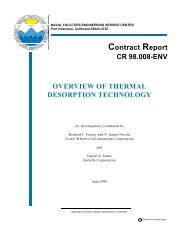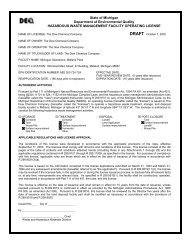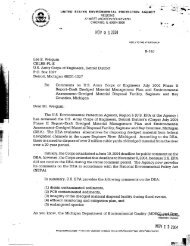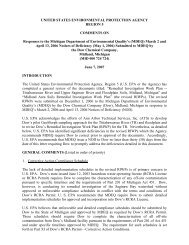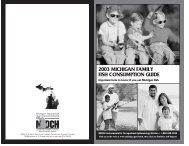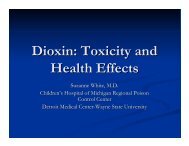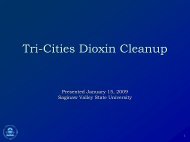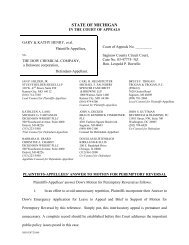Tittabawassee River and Flood Plain SOW - State of Michigan
Tittabawassee River and Flood Plain SOW - State of Michigan
Tittabawassee River and Flood Plain SOW - State of Michigan
Create successful ePaper yourself
Turn your PDF publications into a flip-book with our unique Google optimized e-Paper software.
REMEDIAL INVESTIGATION<br />
SCOPE OF WORK<br />
FOR CORRECTIVE ACTION BEYOND THE FACILITY BOUNDARY<br />
TITTABAWASSEE RIVER AND FLOODPLAIN<br />
PURPOSE<br />
Dow’s Hazardous Waste Site Operating License (“License”), Condition XI.B.2., issued<br />
on June 12, 2002, requires Dow to submit to the <strong>Michigan</strong> Department <strong>of</strong> Environmental<br />
Quality (“MDEQ”) for review <strong>and</strong> approval a Scope <strong>of</strong> Work (“<strong>SOW</strong>”) for conducting<br />
Remedial Investigation ("RI") <strong>of</strong> the <strong>Tittabawassee</strong> <strong>River</strong> Sediments <strong>and</strong> <strong>Flood</strong>plain. The<br />
<strong>SOW</strong> outlines the general steps involved in the implementation <strong>of</strong> a RI, which will be<br />
elaborated upon in the RI Workplan that will be submitted to MDEQ for review <strong>and</strong><br />
approval following approval <strong>of</strong> the <strong>SOW</strong>.<br />
The License also requires Dow to propose Interim Remedial Activities <strong>and</strong> a Public<br />
Participation Plan along with the <strong>SOW</strong>.<br />
The <strong>SOW</strong> is intended to be a preliminary outline that provides an overview <strong>of</strong> the<br />
contents <strong>of</strong> the RI Workplan that Dow will prepare after approval <strong>of</strong> the <strong>SOW</strong> by MDEQ.<br />
The RI Workplan will be developed by Dow working with the MDEQ after Dow <strong>and</strong><br />
MDEQ receive public input on the <strong>SOW</strong>. As it is developed, the RI Workplan may vary<br />
from the <strong>SOW</strong> in its organization, task, prioritization <strong>of</strong> activities, or other aspects,<br />
subject to MDEQ approval.<br />
Outline <strong>of</strong> the <strong>SOW</strong><br />
TASK I:<br />
INTERIM RESPONSE ACTIONS<br />
A. <strong>River</strong>side Boulevard<br />
B. Immerman Memorial Park<br />
C. Freel<strong>and</strong> Festival Park<br />
D. West <strong>Michigan</strong> Park<br />
E. Mapping<br />
F. Wild Game Evaluation<br />
G. Community Information Center<br />
H. Public Information Materials<br />
TASK II:<br />
DESCRIPTION OF CURRENT CONDITIONS<br />
A. Area Background<br />
B. Summary <strong>of</strong> Existing Data<br />
C. Definition <strong>of</strong> Data Gaps<br />
1
TASK III:<br />
RI WORKPLAN REQUIREMENTS<br />
A. Project Management Plan<br />
B. Data Collection Quality Assurance Project Plan<br />
C. Data Management Plan<br />
TASK IV:<br />
REMEDIAL INVESTIGATION<br />
A. Environmental Setting<br />
B. Evaluation <strong>of</strong> Potential for Continuing Sources<br />
C. Characterization <strong>of</strong> <strong>Tittabawassee</strong> <strong>River</strong> Sediments <strong>and</strong><br />
<strong>Flood</strong>plain Soils<br />
D. Prioritization <strong>and</strong> Identification <strong>of</strong> Locations for Further Sampling<br />
E. Current <strong>and</strong> Reasonably Anticipated Receptor Identification<br />
F. Human Health Risk Assessment<br />
G. Ecological Risk Assessment<br />
H. Data Analysis<br />
TASK V:<br />
REPORTS<br />
A. Description <strong>of</strong> Current Conditions<br />
B. RI Workplan<br />
C. RI Report<br />
D. IRA Reports<br />
TASK VI:<br />
PUBLIC PARTICIPATION PLAN<br />
A. Fact Sheets<br />
B. Mailing List<br />
C. Community Information Center<br />
D. Public Meetings<br />
PROPOSED SCHEDULE OF TASKS<br />
SCHEDULE OF SUBMISSIONS<br />
2
TASK I:<br />
INTERIM RESPONSE ACTIVITIES<br />
Condition XI.B.3.(a) <strong>of</strong> the License requires Dow to propose to MDEQ immediate<br />
Interim Response Activities (“IRAs”) based on existing data. Following MDEQ approval<br />
<strong>of</strong> an IRA, Dow will submit an IRA Workplan for review <strong>and</strong> approval as provided for in<br />
License Condition XI.G.<br />
IRA Workplans will be prepared for review <strong>and</strong> approval by the MDEQ, <strong>and</strong> will include<br />
the following:<br />
• A description <strong>of</strong> the objectives <strong>of</strong> the response activity <strong>and</strong> how they will be<br />
achieved;<br />
• A legal description <strong>of</strong> the specific parcel <strong>of</strong> property addressed by the interim<br />
response activity;<br />
• A detailed description <strong>of</strong> the response activity to be undertaken, including all data that<br />
are relevant to the conclusions drawn; <strong>and</strong><br />
• A schedule for implementation <strong>of</strong> the proposed activity.<br />
IRAs are immediate actions based on available data that may not be final remedial<br />
actions <strong>and</strong> are activities undertaken to address potential human exposure pathways. The<br />
IRAs identified below will be implemented in advance <strong>of</strong> the RI.<br />
As requested by MDEQ, <strong>and</strong> without admission by Dow as to the need for the such<br />
measures, the following constitute the immediate IRAs to be undertaken by Dow:<br />
A. Dow will meet <strong>and</strong> consult with residents on <strong>River</strong>side Blvd <strong>and</strong> <strong>of</strong>fer to conduct soil<br />
<strong>and</strong> blood sampling as well as an evaluation <strong>of</strong> human exposure, in advance <strong>of</strong> the RI<br />
activities.<br />
1. The proposed human exposure evaluation would be conducted for the purpose <strong>of</strong><br />
determining relevant exposure pathways.<br />
2. The contents <strong>of</strong> the exposure evaluation would be determined based upon<br />
consultation with residents, the MDEQ, <strong>and</strong> appropriate health <strong>of</strong>ficials.<br />
3. The results <strong>of</strong> the evaluations would be presented <strong>and</strong> explained to the<br />
participating residents based on comparison data.<br />
4. The results <strong>of</strong> the evaluation would be used as the basis for proposal for further<br />
appropriate actions.<br />
3
B. Imerman Memorial Park:<br />
1. Dow will propose to MDEQ a sampling <strong>and</strong> analysis plan to further characterize<br />
the soil to determine relevant exposure pathways.<br />
2. The results <strong>of</strong> the characterization will be used as the basis for a proposal for<br />
further appropriate action.<br />
3. In advance <strong>of</strong> the implementation <strong>of</strong> the characterization plan Dow will propose<br />
<strong>and</strong> receive community input on measures that could be readily implemented to<br />
reduce exposure to soils.<br />
4. Measures, subject to park management approval, will include provision <strong>of</strong> wash<br />
stations, the installation <strong>of</strong> alternative surfacing over exposed soil in high traffic<br />
areas (e.g. mulch, play surfacing, paving, etc.), <strong>and</strong> the construction <strong>of</strong> alternative<br />
play.<br />
5. All work in the park, both investigation <strong>and</strong> exposure reduction measures, will be<br />
coordinated with the park management <strong>of</strong>ficials.<br />
C. Freel<strong>and</strong> Festival Park:<br />
1. Dow will propose to MDEQ a sampling <strong>and</strong> analysis plan to further characterize<br />
the soil to determine relevant exposure pathways.<br />
2. The results <strong>of</strong> the characterization will be used as the basis for a proposal for<br />
further appropriate action.<br />
3. In advance <strong>of</strong> the implementation <strong>of</strong> the characterization plan Dow will propose<br />
<strong>and</strong> receive community input on measures that could be readily implemented to<br />
reduce exposure to soils.<br />
4. Measures, subject to park management approval, will include provision <strong>of</strong> wash<br />
stations, the installation <strong>of</strong> alternative surfacing over exposed soil in high traffic<br />
areas (e.g. mulch, play surfacing, paving, etc.), <strong>and</strong> the construction <strong>of</strong> alternative<br />
play areas.<br />
5. All work in the park, both investigation <strong>and</strong> exposure reduction measures, will be<br />
coordinated with the park management <strong>of</strong>ficials.<br />
D. West <strong>Michigan</strong> Park:<br />
1. Dow will propose to MDEQ a sampling <strong>and</strong> analysis plan to further characterize<br />
the soil to determine relevant exposure pathways.<br />
4
2. The results <strong>of</strong> the characterization will be used as the basis for a proposal for<br />
further appropriate action.<br />
3. In advance <strong>of</strong> the implementation <strong>of</strong> the characterization plan Dow will propose<br />
<strong>and</strong> receive community input on measures that could be readily implemented to<br />
reduce exposure to soils.<br />
4. Measures will include, subject to park management approval, provision <strong>of</strong> wash<br />
stations, <strong>and</strong> the construction <strong>of</strong> alternative play areas.<br />
5. All work in the park, both investigation <strong>and</strong> exposure reduction measures, will be<br />
coordinated with the park management <strong>of</strong>ficials.<br />
E. Dow will prepare comprehensive mapping <strong>of</strong> the <strong>Tittabawassee</strong> <strong>River</strong> <strong>and</strong><br />
<strong>Flood</strong>plain.<br />
1. The mapping will be used to identify information relevant to exposure pathways<br />
(e.g. l<strong>and</strong> use categories, sampling data locations, topography, FEMA floodplain<br />
information, etc.).<br />
2. The mapping will be periodically updated with information as it becomes<br />
available.<br />
F. Dow will conduct a preliminary evaluation <strong>of</strong> wild game (e.g. turkey, deer).<br />
1. This preliminary evaluation will begin the process <strong>of</strong> assessing the potential<br />
human exposure pathway <strong>of</strong> game consumption for game taken from the<br />
<strong>Flood</strong>plain.<br />
2. This preliminary study will be the basis for a more complete evaluation that will<br />
be part <strong>of</strong> the RI.<br />
3. This preliminary evaluation will be coordinated with <strong>State</strong> <strong>and</strong> Federal natural<br />
resources <strong>of</strong>ficials.<br />
4. The information collected will be reported <strong>and</strong> will include available comparison<br />
data.<br />
G. Dow will establish a Community Information Center.<br />
1. The Community Information Center will provide community related information<br />
to assist residents with actions that they can take to reduce the potential for<br />
exposure, as appropriate.<br />
2. The setup <strong>and</strong> the contents <strong>of</strong> the information center will be developed based on<br />
community input.<br />
5
3. The information will also include an explanation <strong>of</strong> the RI process as well as<br />
information about the RI itself, which will be updated during the course <strong>of</strong> the RI.<br />
H. Dow will develop public information materials.<br />
1. The public information materials will be made available through the Community<br />
Information Center to assist residents with actions that they can take to reduce the<br />
potential for exposure.<br />
2. The information materials will cover topics <strong>of</strong> interest to residents (e.g. dust<br />
mitigation, h<strong>and</strong>ling <strong>of</strong> home, grown vegetables, etc.) <strong>and</strong> will be developed for<br />
different segments <strong>of</strong> the community (e.g. educational information for schools,<br />
information for homeowners, for contractors, etc).<br />
TASK II:<br />
DESCRIPTION OF CURRENT CONDITIONS<br />
Dow will submit for MDEQ approval a report providing background information<br />
pertinent to the <strong>Tittabawassee</strong> <strong>River</strong> Sediment <strong>and</strong> <strong>Flood</strong>plain. This report will include<br />
information gathered during previous investigations where the information is publicly<br />
available, Dow generated data, as well as other relevant data, which would help<br />
characterize the current conditions <strong>of</strong> <strong>Tittabawassee</strong> <strong>River</strong> Sediment <strong>and</strong> <strong>Flood</strong>plain. The<br />
Current Condition report will summarize the regional location, pertinent boundary<br />
features, general physiography, topography, river sediments <strong>and</strong> current l<strong>and</strong> use for the<br />
<strong>Tittabawassee</strong> <strong>River</strong> <strong>and</strong> <strong>Flood</strong>plain.<br />
A. Area Background:<br />
The Current Conditions report will include map(s) that will be prepared to depict the<br />
following:<br />
1. General geographic location;<br />
2. Property lines will be delineated in the 100 year flood plain, with the owners <strong>of</strong><br />
property clearly indicated;<br />
3. Topography, waterways, wetl<strong>and</strong>s, floodplains, water features, drainage patterns;<br />
<strong>and</strong><br />
4. Color coding indicating the <strong>Michigan</strong> l<strong>and</strong> use categories <strong>of</strong> property in the<br />
<strong>Tittabawassee</strong> <strong>River</strong>’s 100 year <strong>Flood</strong>plain.<br />
6
B. Summary <strong>of</strong> Existing Data<br />
The Current Conditions report will describe the existing information on the presence<br />
<strong>of</strong> dioxins <strong>and</strong> furans (the “chemicals <strong>of</strong> concern”) in <strong>Tittabawassee</strong> <strong>River</strong> Sediment<br />
<strong>and</strong> <strong>Flood</strong>plain.<br />
1. Available monitoring data <strong>and</strong> qualitative information on locations <strong>and</strong><br />
levels <strong>of</strong> chemicals <strong>of</strong> concern in <strong>Tittabawassee</strong> <strong>River</strong> Sediment <strong>and</strong> <strong>Flood</strong>plain;<br />
2. A preliminary description <strong>of</strong> the geology, soils, physiography, <strong>and</strong> meteorology<br />
for the <strong>Tittabawassee</strong> <strong>River</strong> <strong>and</strong> <strong>Flood</strong>plain; <strong>and</strong><br />
3. Available data on animals, fish, <strong>and</strong> other species endemic to or expected to be<br />
living in the <strong>Tittabawassee</strong> <strong>River</strong> or <strong>Flood</strong>plain.<br />
C. Definition <strong>of</strong> Data Gaps<br />
The Current Conditions report will address the following:<br />
1. Identification <strong>of</strong> the portions <strong>of</strong> the <strong>Tittabawassee</strong> <strong>River</strong> Sediments <strong>and</strong>/or<br />
<strong>Flood</strong>plain where additional information is necessary; <strong>and</strong><br />
2. Identification <strong>of</strong> the type <strong>of</strong> additional information necessary to characterize the<br />
nature <strong>and</strong> extent <strong>of</strong> chemicals <strong>of</strong> concern in the <strong>River</strong> sediment <strong>and</strong> the<br />
<strong>Flood</strong>plain soil.<br />
a. Identification <strong>and</strong> explanation <strong>of</strong> what media (sediment, soil, surface water or<br />
air) requires more information in particular segments <strong>of</strong> the <strong>River</strong> <strong>and</strong><br />
<strong>Flood</strong>plain;<br />
b. Identification <strong>and</strong> explanation <strong>of</strong> what additional media does not require<br />
further sampling in particular segments <strong>of</strong> the <strong>River</strong> <strong>and</strong> <strong>Flood</strong>plain;<br />
c. Identification <strong>and</strong> explanation <strong>of</strong> the nature <strong>of</strong> necessary additional sampling;<br />
<strong>and</strong><br />
d. Identification <strong>and</strong> explanation <strong>of</strong> particular events <strong>and</strong> conditions that require<br />
further sampling (e.g. storm <strong>and</strong> flooding events, low flow conditions,<br />
seasonal changes, etc.).<br />
7
TASK III:<br />
RI WORKPLAN REQUIREMENTS<br />
As required by the License, following approval <strong>of</strong> the <strong>SOW</strong>, Dow will prepare a RI<br />
Workplan for evaluation <strong>of</strong> <strong>Tittabawassee</strong> <strong>River</strong> Sediment <strong>and</strong> <strong>Flood</strong>plain. The RI<br />
Workplan will include several components described below. During the implementation<br />
<strong>of</strong> the RI, the RI Workplan may be revised with the approval <strong>of</strong> the MDEQ to meet<br />
changing or unforeseen conditions. The components <strong>of</strong> the RI Workplan will include the<br />
following:<br />
A. Project Management Plan:<br />
The RI Workplan will include a Project Management Plan which will include a<br />
discussion <strong>of</strong> the technical approach, schedules, <strong>and</strong> personnel for conducting the RI.<br />
The Project Management Plan will also include:<br />
1. A description <strong>of</strong> qualifications <strong>of</strong> the personnel performing or directing the RI,<br />
including contractor personnel; <strong>and</strong><br />
2. The overall management approach to the RI.<br />
B. Data Collection Quality Assurance Project Plan:<br />
The RI Workplan will include a plan to document monitoring, sampling, <strong>and</strong><br />
analytical methodology to be used during the RI investigation to characterize the<br />
environmental setting. The Data Collection Strategy section <strong>of</strong> the Data Collection<br />
Quality Assurance Project Plan will include the following:<br />
1. Description <strong>of</strong> the intended uses for the data <strong>and</strong> <strong>of</strong> the necessary level <strong>of</strong><br />
precision <strong>and</strong> accuracy for these intended uses;<br />
2. Description <strong>of</strong> methods <strong>and</strong> procedures to be used; <strong>and</strong><br />
3. Description <strong>of</strong> the rationale used to assure that the data accurately represent a<br />
characteristic <strong>of</strong> a population, or an environmental condition. Examples <strong>of</strong> factors<br />
which will be considered <strong>and</strong> discussed include:<br />
a. Environmental conditions at the time <strong>of</strong> sampling;<br />
b. Number <strong>of</strong> sampling points;<br />
c. Representativeness <strong>of</strong> selected media; <strong>and</strong><br />
d. Representativeness <strong>of</strong> selected analytical parameters.<br />
8
C. Data Management Plan:<br />
The RI Workplan will include a Data Management Plan to document <strong>and</strong> track data<br />
<strong>and</strong> results. This Plan will identify <strong>and</strong> set up data documentation materials <strong>and</strong><br />
procedures.<br />
TASK IV:<br />
REMEDIAL INVESTIGATION<br />
The purpose <strong>of</strong> a RI is to assess conditions in order to select an appropriate remedial<br />
action, if one is required, that adequately addresses those conditions. The remedial<br />
investigation will define the nature <strong>and</strong> extent <strong>of</strong> conditions in the <strong>Tittabawassee</strong> <strong>River</strong><br />
Sediments <strong>and</strong> <strong>Flood</strong>plain.<br />
More specifically, the RI will involve a series <strong>of</strong> investigations necessary to: describe the<br />
current <strong>Tittabawassee</strong> <strong>River</strong> Sediment <strong>and</strong> <strong>Flood</strong>plain conditions (Environmental<br />
Setting); evaluate the potential existence <strong>of</strong> continuing sources <strong>of</strong> chemicals <strong>of</strong> concern in<br />
sediments (Potential Continuing Source Characterization); define the nature <strong>and</strong> extent <strong>of</strong><br />
chemicals <strong>of</strong> concern distribution in the <strong>Tittabawassee</strong> <strong>River</strong> Sediment <strong>and</strong> <strong>Flood</strong>plain<br />
(Characterization <strong>of</strong> the <strong>Tittabawassee</strong> <strong>River</strong> <strong>and</strong> <strong>Flood</strong>plain); identify actual or potential<br />
receptors in <strong>Tittabawassee</strong> <strong>River</strong> Sediment <strong>and</strong> <strong>Flood</strong>plain (Current <strong>and</strong> Reasonably<br />
Anticipated Future Receptor Identification); <strong>and</strong> conduct a risk assessment on human<br />
health (Human Health Risk Assessment) <strong>and</strong> on ecological receptors (Ecological Risk<br />
Assessment). The results <strong>of</strong> these evaluations will be summarized <strong>and</strong> in the RI report<br />
<strong>and</strong> the individual reports incorporated into the RI by reference.<br />
A. Environmental Setting:<br />
Information will be collected to supplement existing information on the<br />
environmental setting <strong>of</strong> the Tittawabassee <strong>River</strong> <strong>and</strong> <strong>Flood</strong>plain in order to<br />
characterize the following:<br />
1. <strong>River</strong> Conditions. The RI will include:<br />
a. A description <strong>of</strong> the Tittawabassee <strong>River</strong> <strong>and</strong> watershed related to the study<br />
area including:<br />
i) Location, elevation, flow, velocity <strong>and</strong> volume;<br />
ii) Location, elevation, <strong>and</strong> width <strong>of</strong> seasonal fluctuations <strong>and</strong> flooding<br />
characteristics (i.e., 100-year event);<br />
iii) Depth <strong>and</strong> bottom characterization;<br />
iv) Hydrodynamic modeling; <strong>and</strong><br />
9
v) Drainage patterns.<br />
b. Description <strong>of</strong> the chemistry <strong>of</strong> the surface water <strong>and</strong> sediments (i.e. pH, total<br />
organic carbon).<br />
c. Description <strong>of</strong> sediment characteristics, including:<br />
i) Deposition <strong>and</strong> erosion area(s) <strong>and</strong> rates;<br />
ii) Thickness pr<strong>of</strong>ile; <strong>and</strong><br />
iii) Physical <strong>and</strong> chemical parameters (e.g., grain size, density, organic carbon<br />
content, pH).<br />
d. Sediment transport, including:<br />
i) Sediment movement from the river to the floodplain; <strong>and</strong><br />
ii) Sediment <strong>and</strong> soil movement from the floodplain to the river.<br />
2. <strong>Flood</strong>plain Soils. The RI will provide for a general classification <strong>and</strong> description<br />
<strong>of</strong> the soils in the <strong>Tittabawassee</strong> <strong>River</strong> <strong>and</strong> <strong>Flood</strong>plain that will include:<br />
a. Surface soil distribution;<br />
b. Soil pr<strong>of</strong>ile, including American St<strong>and</strong>ard Test Method (ASTM) classification<br />
<strong>of</strong> soils;<br />
c. Transects <strong>of</strong> soil stratigraphy;<br />
d. Soil sorptive capacity;<br />
e. Cation exchange capacity;<br />
f. Soil organic content;<br />
g. Soil pH;<br />
h. Particle size distribution; <strong>and</strong><br />
i. Mineral content.<br />
3. Climate. Climate in the study area will be characterized by,<br />
a. Annual <strong>and</strong> monthly rainfall averages;<br />
10
. Definition <strong>of</strong> less than 100 year <strong>Flood</strong>plain areas (e.g. 1 yr, 5 yr, 25 yr, 50yr<br />
floodplain areas);<br />
c. Monthly temperature averages <strong>and</strong> extremes;<br />
d. Wind speed <strong>and</strong> direction; <strong>and</strong><br />
e. Evaporation data.<br />
B. Evaluation <strong>of</strong> the Potential for Continuing Sources:<br />
The RI will include an evaluation <strong>of</strong> whether there are any continuing sources <strong>of</strong><br />
chemicals <strong>of</strong> concern in the <strong>Tittabawassee</strong> <strong>River</strong> sediments by reviewing the<br />
information collected under subtask IV. A., IV.C. <strong>and</strong> IV.D. The RI will coordinate<br />
with License Condition X.M - Surface Water Monitoring Program, under which Dow<br />
will implement a program to monitor surface water to determine if the Dow facility is<br />
a source <strong>of</strong> chemicals <strong>of</strong> concern to the <strong>Tittabawassee</strong> <strong>River</strong>. If continuing sources<br />
are identified they will be characterized as follows:<br />
1. Location <strong>of</strong> source area; <strong>and</strong><br />
2. Known information on nature <strong>and</strong> extent <strong>of</strong> source area.<br />
C. Characterization <strong>of</strong> <strong>Tittabawassee</strong> <strong>River</strong> Sediments <strong>and</strong> <strong>Flood</strong>plain Soils, fish <strong>and</strong><br />
wildlife:<br />
The RI will collect analytical data on soils, surface water, <strong>and</strong> sediment, as<br />
appropriate, in the <strong>Tittabawassee</strong> <strong>River</strong> <strong>and</strong> <strong>Flood</strong>plain. The RI will also collect <strong>and</strong><br />
analyze fish <strong>and</strong> other wildlife that live in <strong>Tittabawassee</strong> <strong>River</strong> <strong>and</strong> on the <strong>Flood</strong>plain.<br />
These data shall be sufficient to define the concentrations <strong>of</strong> chemicals <strong>of</strong> concern in<br />
the study area.<br />
1. Statistical Sampling <strong>of</strong> Sediments <strong>and</strong> <strong>Flood</strong>plain Soils:<br />
a. Based on the Data Gap analysis (Task II.C.), locations for sampling will be<br />
identified <strong>and</strong> sampling will be conducted <strong>of</strong> sediments or soils;<br />
b. A statistical sampling approach will be applied;<br />
c. The approach chosen will result in a sampling plan that will characterize the<br />
concentration <strong>of</strong> chemicals <strong>of</strong> concern in the <strong>Tittabawassee</strong> <strong>River</strong> sediments<br />
<strong>and</strong> <strong>Flood</strong>plain soils; <strong>and</strong><br />
d. Further characterization <strong>and</strong> evaluation <strong>of</strong> sediment layers relative to<br />
chemicals <strong>of</strong> concern concentrations, deposition rates relative to geologic<br />
11
events, <strong>and</strong> relationship (if any) between total organic carbon <strong>and</strong> chemicals<br />
<strong>of</strong> concern concentrations will be conducted.<br />
2. Sampling <strong>of</strong> Fish <strong>and</strong> Wildlife:<br />
a. The RI will collect samples <strong>of</strong> fish, game animals <strong>and</strong> other species in support<br />
<strong>of</strong> the evaluations to be conducted under subtasks IV.E., IV.F <strong>and</strong> IV.G. with<br />
respect to receptor identification <strong>and</strong> human <strong>and</strong> ecological risk assessments.<br />
b. The sampling <strong>of</strong> fish, game animals <strong>and</strong> other species will be coordinated with<br />
<strong>State</strong> <strong>and</strong> Federal natural resource <strong>of</strong>ficials.<br />
3. Additional Sampling:<br />
If the analysis <strong>of</strong> the sampling results indicate that additional information is<br />
needed for characterization, then additional sampling will be conducted.<br />
D. Prioritization <strong>and</strong> Identification <strong>of</strong> Location for Sampling<br />
The RI sampling work for Task IV.C. will be prioritized based upon the potential for<br />
human exposure <strong>and</strong> presence <strong>of</strong> the highest concentrations <strong>of</strong> chemicals <strong>of</strong> concern.<br />
A variety <strong>of</strong> evaluations will be performed on existing data to determine what<br />
additional data is required to be able to generate site specific criteria as provided for<br />
in License Condition XI.B.3.b(iv) <strong>and</strong> to aid in the prioritization activities. As an<br />
example, humans that either live on or have access to the <strong>Flood</strong>plain have greater<br />
potential to come in contact with chemicals <strong>of</strong> concern via soil contact; therefore, the<br />
priority <strong>of</strong> the RI characterization activities will focus first on <strong>Flood</strong>plain soils, then<br />
move on to <strong>River</strong> Sediments.<br />
1. The following activities will be incorporated into the evaluation <strong>of</strong> the<br />
prioritization <strong>of</strong> investigative activities in the <strong>Tittabawassee</strong> <strong>Flood</strong>plain:<br />
a. Using FEMA maps, topographic maps, observations <strong>of</strong> <strong>River</strong> features, aerial<br />
photographs, <strong>and</strong> surveys <strong>of</strong> residents <strong>and</strong> <strong>of</strong>ficials, to determine those<br />
portions <strong>of</strong> the <strong>Flood</strong>plain that are most frequently flooded;<br />
b. Identifying the areas in the <strong>Flood</strong>plain that are most frequently flooded <strong>and</strong><br />
are in greatest proximity to residences <strong>and</strong> other places where the public is<br />
likely to frequent;<br />
c. The sampling data that shows the concentrations <strong>and</strong> depths <strong>of</strong> the location <strong>of</strong><br />
the chemicals <strong>of</strong> concern identified will be compared with the locations where<br />
there is significant human activity in order to determine where there is the<br />
highest potential for exposure to the highest concentrations <strong>of</strong> chemicals <strong>of</strong><br />
concern;<br />
12
d. A lower priority will be placed on the infrequently flooded areas (e.g. due to<br />
higher property elevations <strong>and</strong> distance from the <strong>River</strong> bank), on current l<strong>and</strong><br />
uses with less exposure potential, <strong>and</strong> areas in the <strong>Flood</strong>plain that have not<br />
been developed; <strong>and</strong><br />
e. The prioritization may change based on the conclusions that are drawn from<br />
data that are collected (i.e. an iterative approach).<br />
2. The timing <strong>of</strong> RI activities may be affected by the need to obtain permission for<br />
access to property, the requirement to obtain permits from governmental agencies,<br />
weather <strong>and</strong> other conditions which Dow cannot control.<br />
E. Current <strong>and</strong> Reasonably Anticipated Receptor Identification:<br />
Human populations <strong>and</strong> ecological habitats that come in contact with chemicals <strong>of</strong><br />
concern through contact with <strong>Tittabawassee</strong> <strong>River</strong> Sediment <strong>and</strong> <strong>Flood</strong>plain soils will<br />
be characterized. If present, any observable impacts to ecological habitants or<br />
receptors will be described.<br />
The following characteristics will be identified:<br />
1. Current <strong>and</strong> reasonably anticipated future human use <strong>of</strong> or access to the<br />
<strong>Tittabawassee</strong> <strong>River</strong> <strong>and</strong> <strong>Flood</strong>plain including, but not limited to:<br />
a. Types <strong>of</strong> current <strong>and</strong> reasonably anticipated future uses (e.g. residential,<br />
commercial, zoning/deed restrictions, etc.);<br />
b. Any use restrictions relative to the <strong>Tittabawassee</strong> <strong>River</strong> <strong>and</strong> <strong>Flood</strong>plain <strong>and</strong><br />
the locations where significant concentrations <strong>of</strong> chemicals <strong>of</strong> concern are<br />
present; <strong>and</strong><br />
c. Evaluation <strong>of</strong> other use patterns relative to potential human exposure<br />
pathways.<br />
2. A general description <strong>of</strong> the ecosystem overlying <strong>and</strong> in proximity to the<br />
<strong>Tittabawassee</strong> <strong>River</strong> <strong>and</strong> <strong>Flood</strong>plain including, but not limited to:<br />
a. Location <strong>and</strong> size <strong>of</strong> major habitat types (e.g., streams, wetl<strong>and</strong>s, forested<br />
areas);<br />
b. Several species composition <strong>and</strong> relative abundance <strong>of</strong> plant <strong>and</strong> animal<br />
species that utilize these habitants;<br />
13
c. Documentation <strong>of</strong> the potential presence <strong>of</strong> any federal or state listed<br />
threatened, endangered, or rare species; or unique habitants through contact<br />
with <strong>State</strong> <strong>and</strong> Federal resource agencies <strong>and</strong><br />
d. Evaluation <strong>of</strong> other potential exposure pathways to ecological species <strong>and</strong>/or<br />
systems present in the <strong>Tittabawassee</strong> <strong>River</strong> <strong>and</strong>/or <strong>Flood</strong>plain. A<br />
demographic pr<strong>of</strong>ile <strong>of</strong> the people who use or have access to the<br />
<strong>Tittabawassee</strong> <strong>River</strong> <strong>and</strong> <strong>Flood</strong>plain.<br />
4. Studies will be conducted to support the evaluation <strong>of</strong> Potential Human Exposure<br />
Pathways:<br />
a. A study to collect actual data on the residential, recreational, agricultural,<br />
commercial <strong>and</strong> other uses <strong>of</strong> the <strong>River</strong> <strong>and</strong> <strong>Flood</strong>plain;<br />
b. A bioavailability study will be performed to determine what portion <strong>of</strong><br />
chemicals <strong>of</strong> concern found in <strong>Tittabawassee</strong> <strong>River</strong> Sediments <strong>and</strong> <strong>Flood</strong>plain<br />
soils are biologically available as determined by in vivo laboratory studies<br />
with soil taken from the study area;<br />
c. An evaluation <strong>of</strong> plant uptake <strong>of</strong> chemicals <strong>of</strong> concern will be performed to<br />
determine the likelihood that vegetables or fruits represent a significant risk <strong>of</strong><br />
exposure;<br />
d. An evaluation <strong>of</strong> potential inhalation exposure pathways will be conducted;<br />
<strong>and</strong><br />
e. An evaluation <strong>of</strong> direct skin contact exposure will be conducted, to determine<br />
human absorption rates <strong>of</strong> chemicals <strong>of</strong> concern from <strong>Tittabawassee</strong> <strong>River</strong><br />
Sediments <strong>and</strong> <strong>Flood</strong>plain soils.<br />
F. Human Health Risk Assessment:<br />
Dow will conduct site-specific risk assessments for the <strong>Tittabawassee</strong> <strong>River</strong> <strong>and</strong><br />
<strong>Flood</strong>plain utilizing available data as well as data that will be generated during the RI<br />
to develop site-specific criteria as provided for in License Condition XI.B.3.b(iv).<br />
This will include risk assessments based on site-specific exposure parameters coupled<br />
with probabilitistic (e.g. Monte Carlo) approaches. This risk assessment process is<br />
summarized in the following steps.<br />
1. Exposure Assessment: As required in Condition XI B. 3.(b), Dow will evaluate<br />
the level <strong>and</strong> routes <strong>of</strong> potential exposure to chemicals <strong>of</strong> concern to humans via<br />
<strong>Tittabawassee</strong> <strong>River</strong> Sediments <strong>and</strong> <strong>Flood</strong>plain soils. Exposure assessment<br />
includes information gathered from Task IV along with an evaluation <strong>of</strong> all<br />
exposure pathways <strong>and</strong> their frequency relevant to <strong>Flood</strong>plain residents.<br />
14
a. The initial exposure pathways to be evaluated are listed in the Part 201<br />
regulations; <strong>and</strong><br />
b. Additional exposure pathways will be identified <strong>and</strong> evaluated.<br />
2. Toxicity Assessment/Hazard Identification: Toxicity assessment is equivalent to<br />
hazard identification; <strong>and</strong><br />
3. Risk Characterization: The risk characterization will summarize <strong>and</strong> combine the<br />
output <strong>of</strong> the preceding steps by computing estimates <strong>of</strong> risk. Probabilistic risk<br />
assessment will be used to present a range <strong>of</strong> potential risks. In addition, risk<br />
estimates will be presented in terms <strong>of</strong> a theoretical cancer risk (i.e., one in one<br />
hundred thous<strong>and</strong>), a hazard quotient for non-cancer endpoints (i.e., how the<br />
estimated daily dioxin dosage relates to the tolerable daily intake dosage) or<br />
establishing floodplain soil <strong>and</strong> sediment concentrations that do not pose an<br />
unacceptable risk. An analysis <strong>of</strong> uncertainties that affect the level <strong>of</strong> confidence<br />
inherent in these risk estimates will be provided.<br />
G. Ecological Risk Assessment:<br />
Properly analyzing the ecological risks associated with residues in sediments <strong>and</strong>/or<br />
soils is a complicated, multifaceted task best addressed within the framework <strong>of</strong> an<br />
ecological or environmental risk assessment. Critical sediment <strong>and</strong> chemical fate <strong>and</strong><br />
transport processes (fate, mobility, <strong>and</strong> availability) in relation to the spatial <strong>and</strong><br />
temporal distribution <strong>of</strong> chemicals <strong>of</strong> concern will be studied in <strong>Tittabawassee</strong> <strong>River</strong><br />
Sediment <strong>and</strong> <strong>Flood</strong>plain. A baseline ecological risk study to be conducted by<br />
<strong>Michigan</strong> <strong>State</strong> University will be initiated in the advance <strong>of</strong> the RI. The<br />
environmental risk assessment process consists <strong>of</strong> the following steps:<br />
1. Problem Formulation: This initial step involves the establishment <strong>of</strong> the goals,<br />
breadth, <strong>and</strong> focus <strong>of</strong> the ecological risk assessment, resulting in the ecological<br />
conceptual model. The conceptual model describes how the chemicals <strong>of</strong> concern<br />
might affect the potential ecological receptors, <strong>and</strong> identifies assessment <strong>and</strong><br />
measurement endpoints. The problem formulation step is used both for screening<br />
purposes <strong>and</strong> to refine the baseline ecological risk assessment.<br />
2. Analysis: This step examines both the ecological effect endpoints <strong>and</strong> the<br />
chemical exposure assessment. The exposure assessment can include exposure<br />
pathways <strong>and</strong> characterization <strong>of</strong> likely exposure scenarios for potential<br />
ecological receptors. Alternatively or in addition, the analysis phase will include<br />
field measurements <strong>of</strong> potentially affected populations compared to reference<br />
populations, <strong>and</strong>/or measurement <strong>of</strong> chemical residues in receptors <strong>and</strong> media <strong>of</strong><br />
interest.<br />
15
3. Risk Characterization: A weight-<strong>of</strong>-evidence approach is used to examine the<br />
field data, interpret the relationship between exposure <strong>and</strong> effects, <strong>and</strong> generate<br />
risk estimates for the assessment endpoints. The risk characterization includes a<br />
qualitative <strong>and</strong> quantitative evaluation <strong>of</strong> the overall risks posed to wildlife<br />
organisms <strong>and</strong> the associated uncertainties.<br />
H. Data Analysis:<br />
Dow will analyze the investigation data outlined in this Task <strong>and</strong> prepare a report.<br />
The objective <strong>of</strong> the data analysis section is to summarize the results <strong>of</strong> the analysis<br />
collected for the RI <strong>and</strong> its report. The analysis will also ensure data quality<br />
assurance procedures have been followed.<br />
TASK V:<br />
REPORTS<br />
Draft <strong>and</strong> final reports will be prepared that communicate the results <strong>of</strong> Tasks I through<br />
IV. These reports will be submitted in accordance with the schedule contained in the<br />
License <strong>and</strong> the RI Workplan, upon its approval:<br />
A. Interim Response Actions (Task I)<br />
B. Description <strong>of</strong> Current Conditions (Task II)<br />
C. RI Workplan (Task III)<br />
D. RI Report (Task IV)<br />
TASK VI:<br />
PUBLIC PARTICIPATION PLAN<br />
It is anticipated that the following types <strong>and</strong> means <strong>of</strong> communication with the<br />
public will occur during the process outlined above. The specific actions to be<br />
taken will be based on, in part, the level <strong>of</strong> community interest in various tasks<br />
<strong>and</strong> what is needed to keep the public apprised <strong>of</strong> significant developments in the<br />
RI process:<br />
A. Fact Sheets. Dow will prepare Fact Sheets to be reviewed by MDEQ that will<br />
address key topics <strong>and</strong> milestones <strong>of</strong> interest to the community (e.g. the<br />
Corrective Action process, IRAs, the RI Workplan, RI Findings, etc.). These<br />
Fact Sheets will be made available in the Community Information Center <strong>and</strong><br />
on the Dow website.<br />
16
B. Mailing List. Dow will prepare <strong>and</strong> maintain a mailing that can be used by<br />
Dow <strong>and</strong> the MDEQ to facilitate communication <strong>of</strong> events <strong>and</strong> information<br />
related to the RI process.<br />
C. Community Information Center.<br />
1. Paper Document Collection. Dow will secure <strong>and</strong> maintain location or<br />
locations within the community where the residents can review copies <strong>of</strong><br />
the relevant documents.<br />
2. Website. Dow will maintain a website that will include copies <strong>of</strong> the<br />
paper documents maintained in the paper document repository.<br />
D. Public Meetings. Dow will arrange for Public Meetings to be held in the<br />
community in places <strong>and</strong> at times convenient for the residents. Small-group<br />
or one-on-one meetings will be held as necessary or appropriate to discuss<br />
concerns. Larger, multi-party meetings or “town meetings” will be held when<br />
that is the appropriate format. Dow will coordinate the scheduling <strong>and</strong><br />
planning <strong>of</strong> Public Meetings with MDEQ.<br />
1. Public Meetings will be scheduled in conjunction with the initial<br />
submission <strong>and</strong> following approval <strong>of</strong> Dow’s written submissions <strong>of</strong><br />
workplans <strong>and</strong> significant reports.<br />
2. Public Meetings will be schedule in coordination with any License<br />
modification activities.<br />
PROPOSED SCHEDULE OF TASKS<br />
The following is a preliminary overview <strong>of</strong> the scheduling <strong>of</strong> the Tasks <strong>and</strong> major subtasks<br />
to be conducted under the RI. More details about the particular sub-tasks <strong>and</strong> their<br />
phasing will be addressed in the RI Workplan.<br />
Tasks<br />
Timing<br />
I. Interim Response Actions<br />
A. <strong>River</strong>side Blvd Immediate implementation pursuant to the<br />
workplan schedule following DEQ approval <strong>of</strong> IRA<br />
workplan<br />
B. Freel<strong>and</strong> Festival Park Immediate implementation pursuant to the<br />
workplan schedule following DEQ approval <strong>of</strong> IRA<br />
workplan<br />
17
PROPOSED SCHEDULE OF TASKS (continued)<br />
Tasks<br />
Timing<br />
C. West <strong>Michigan</strong> Park Immediate implementation pursuant to the<br />
workplan schedule following DEQ approval <strong>of</strong> IRA<br />
workplan<br />
D. Mapping Immediate implementation pursuant to the<br />
workplan schedule following DEQ approval <strong>of</strong> IRA<br />
workplan<br />
E. Wild game evaluation Immediate implementation pursuant to the<br />
workplan schedule following DEQ approval <strong>of</strong> IRA<br />
workplan<br />
F. Community Information Immediate implementation pursuant to the<br />
Center<br />
workplan schedule following DEQ<br />
approval <strong>of</strong> IRA workplan<br />
G. Public Information Immediate implementation pursuant to the<br />
Materials<br />
workplan schedule following DEQ<br />
approval <strong>of</strong> IRA workplan<br />
II. Description <strong>of</strong> Current Conditions (Specific Steps)<br />
A. A workplan will be prepared for the preparation <strong>of</strong> the Current Condition portion<br />
<strong>of</strong> the RI Workplan submitted for DEQ approval 45 days after DEQ approval <strong>of</strong><br />
<strong>SOW</strong><br />
B. The Current Conditions Report will be submitted Definition <strong>of</strong> Data Gaps 180<br />
days after MDEQ approval <strong>of</strong> Current Conditions workplan<br />
III. RI WorkPlan Requirements<br />
A. The Project Management Plan, Data Collection Quality Assurance Project Plan<br />
<strong>and</strong> Data Management Plan will be submitted for DEQ approval 90 days after<br />
DEQ approval <strong>of</strong> the <strong>SOW</strong>.<br />
18
IV. Remedial Investigation<br />
A. The RI Work Plan will be submitted for DEQ approval 60 days after the approval<br />
<strong>of</strong> the Current Conditions Report.<br />
SCHEDULE OF SUBMISSIONS<br />
Dow Submission<br />
Task II Current Conditions Report<br />
RI Workplan<br />
IRA workplan<br />
IRA Implementation<br />
Implementation <strong>of</strong> RI<br />
RI Report<br />
Due Date/Task Commencement Timing*<br />
180 days after MDEQ approval <strong>of</strong> Workplan<br />
60 days after MDEQ approval <strong>of</strong> Current Conditions<br />
Report<br />
60 days after MDEQ approval <strong>of</strong> IRA<br />
Upon MDEQ approval <strong>of</strong> IRA workplan<br />
Upon MDEQ approval <strong>of</strong> RI Workplan<br />
60 days following completion <strong>of</strong> RI<br />
*Dow will apply for any necessary permits or seek access to private property upon the<br />
approval <strong>of</strong> the applicable Workplan.<br />
19



